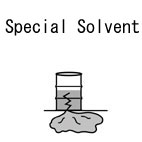| Case Name |
Leakage from a crack of a heat exchanger due to corrosion and abrasion at a manufacturing plant of crude copper phthalocyanine blue |
| Pictograph |

|
| Date |
February 14, 1999 |
| Place |
Kawasaki, Kanagawa, Japan |
| Location |
Chemical factory |
| Overview |
On February 14th, 1999, a solvent was to be separated by evaporation from a reaction mixture containing phthalocyanine at a pigment manufacturer. After starting a depressurizing program at solvent evaporator B, solvent (Hisol-P) spouted in a mist state from a channel cover of the solvent cooler, and spread in the southeastern direction (55 m x max. 30 m) and some of the solvent reached a public road. Causes were decreased thickness of the shell of the heat exchanger due to corrosion and an increase in inner pressure without noticing clogging of tubes of the heat exchanger. |
| Incident |
Clogging and corrosion at a heat exchanger of a reduced pressure evaporation unit caused oil mist spouting. |
| Processing |
Manufacture |
| Individual Process |
Concentration (Evaporation) |
| Substance |
Hisol P(the commercial name of a kind of branched alkyl benzene) |
| Type of Accident |
Leakage |
| Sequence |
At a pigment manufacturer, a solvent was to be separated by evaporation from a reaction mixture containing phthalocyanine. After starting a depressurizing program for solvent evaporator B, the solvent (Hisol-P) spouted as a mist from the channel cover of the solvent cooler. |
| Cause |
1. There was corrosion at a fillet welding between a channel cover and a separation board of a solvent inlet of a heat exchanger. The strength of the shell decreased.
2. Part of the heat transfer tubes of the heat exchanger was clogged, and inner pressure of the channel cover increased.
3. A flow meter for the solvent was defective and a decrease in a flow due to clogging of tubes could not be detected.
4. The increased inner pressure resulted in pinholes at thinner parts of the welding, and the solvent spouted. |
| Response |
A circulation pump was stopped. A solvent in a drain was recovered with a pump. |
| Countermeasures |
1. Specifications for thickness and materials were changed.
2. Strengthening operation management.
3. The flow meter was changed.
4. Full inspection of the heat exchanger, washing bath, and piping was conducted. |
| Knowledge Comment |
1. Facilities should be in a good condition.
2. Serious accidents may be preceded by a small sign. |
| Background |
1. There was corrosion around the welding line between a channel cover and a separation board. It is a failure of facilities management.
2. The facilities were operated in spite of the failed flow meter. It is a failure of operation management.
3. It was noticed that a solvent recovered was much less than that of the previous two operations. If careful inspection had been carried out for this lower solvent recovery rate, the accident could have been prevented. |
| Reason for Adding to DB |
Example of a possibility of overlooking signs of trouble |
| Scenario |
| Primary Scenario
|
Poor Value Perception, Poor Safety Awareness, Inadequate Risk Recognition, Ignorance, Insufficient Knowledge, Convincement, Malicious Act, Rule Violation, Safety Rule Violation, Usage, Operation/Use, Operation without flow meter, Malfunction, Poor System, No Measurement of Flow Rate, Failure, Abrasion, Corrosion, Secondary Damage, External Damage, Leakage
|
|
| Sources |
Kawasaki City Fire fighting station. Prevention division. Peace section. Leakage at a heat exchanger of crude copper phthalocyanine blue manufacturing plant. Material of the Kawasaki City complex safety countermeasures committee. (1999)
|
| Physical Damage |
A channel cover of a heat exchanger cracked. About 600 L of branched alkylbenzene was lost. |
| Financial Cost |
¥3 million. (remedial work cost estimation) (Material of the Kawasaki City Complex safety countermeasures committee) |
| Consequences |
The solvent (Hisol-P) was scattered in the southwestern direction (55 m x max. 30 m) from the reactor. Some reached a public road. |
| Field |
Chemicals and Plants
|
| Author |
YOSHINAGA, Jun (Graduate School of New Frontier Sciences, The University of Tokyo)
TAMURA, Masamitsu (Center for Risk Management and Safety Sciences, Yokohama National University)
|